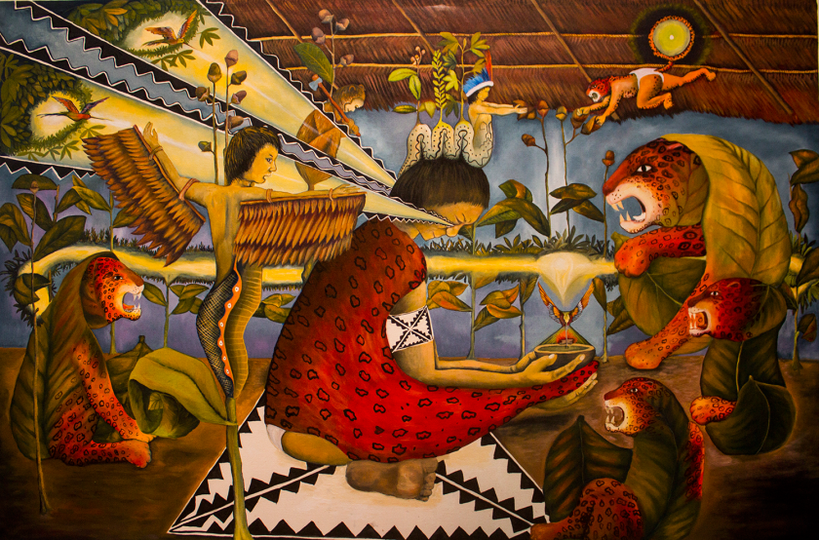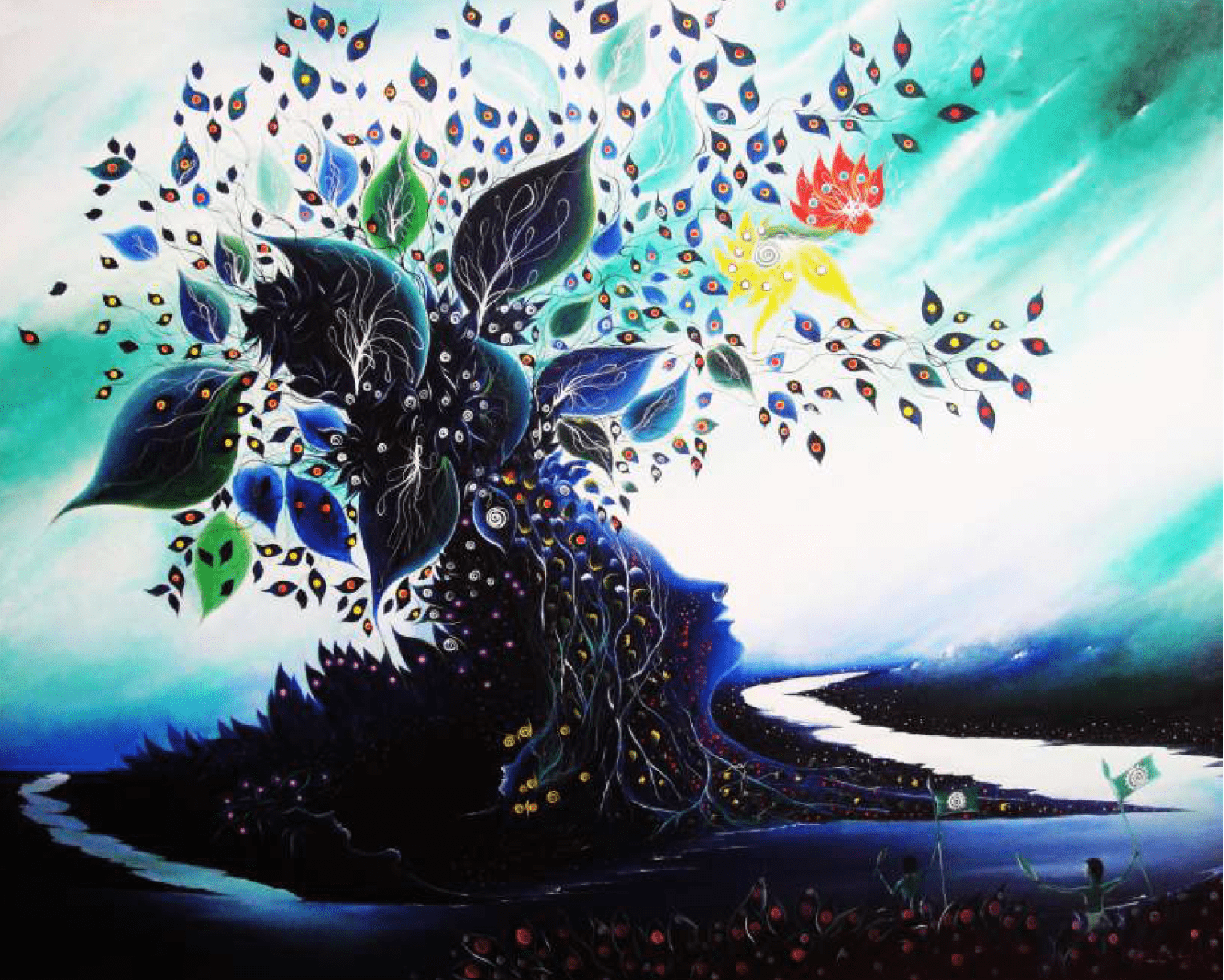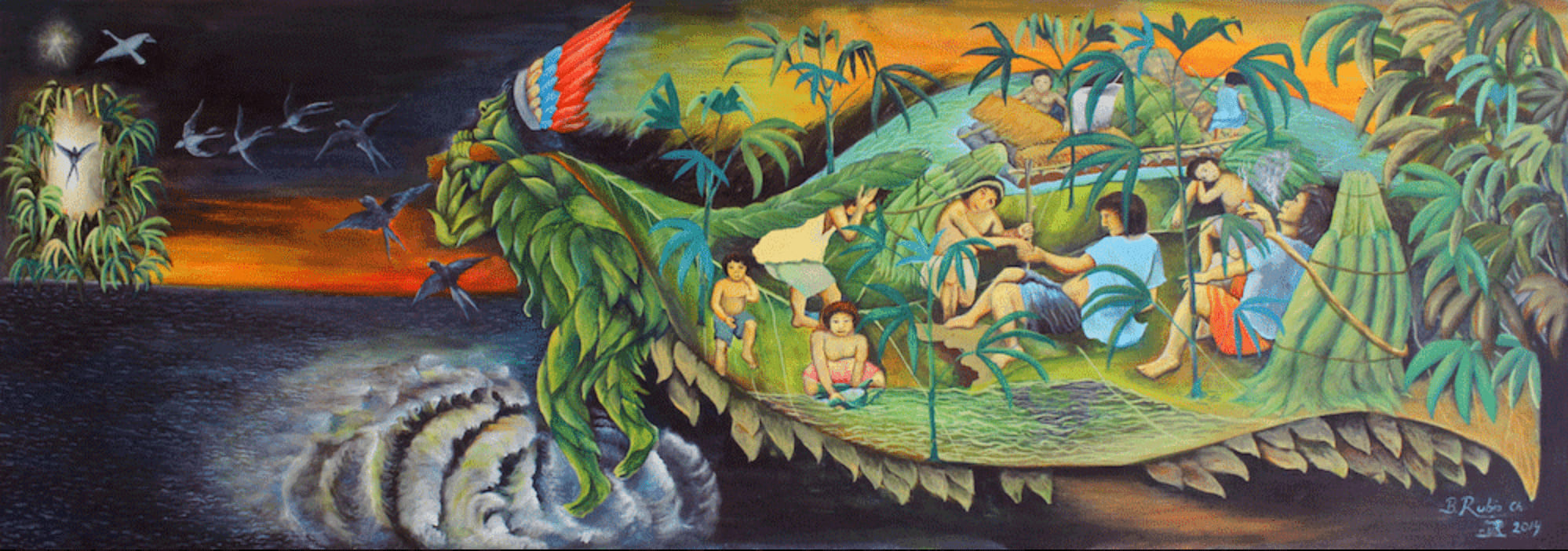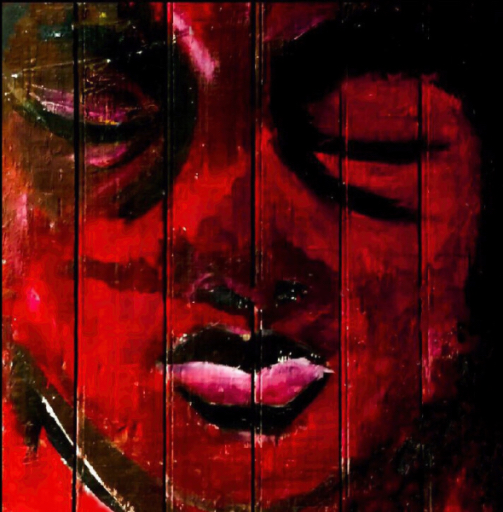
Brus Rubio’s The Meditation depicts a vision where the spiritual, the animal, and the natural world are connected on the same level of consciousness.
Contemporary Indigenous Art of the Amazon
Origin, Tradition, and Cosmovision
Contemporary Indigenous art from the Amazon holds profound cultural relevance. Going beyond preserving traditions, it renews them with vitality. In its contemporary form, it becomes a creative translation of inherited worldviews into new media and contexts. At the same time, it remains deeply connected to cosmology, collective memory, and spiritual knowledge.
Part I: Shared roots—distinct impulses
Contemporary Art from the Amazon unfolds in two distinct,
yet deeply interconnected currents.
Contemporary Indigenous Art
Created by artists belonging to Indigenous communities, whose work
is grounded in tradition, cosmovision, and ancestral knowledge.
Contemporary Amazonian Art
Created by artists from diverse cultural backgrounds, with a strong connection to the Amazon through lived experience, regional belonging, and artistic commitment.
Both artistic traditions share the same geographic origin, the vast Amazon Basin, a unique habitat that profoundly shapes the lives of its inhabitants. However, they arise from different cultural imperatives and artistic approaches.
The following text is dedicated to Contemporary indigenous Art, exploring its distinct characteristics, motivations, and modes of expression. It demonstrates how the art of this region can expand our understanding of identity, creativity, and cultural resilience.
This essay is complemented by another dedicated to Contemporary Amazonian Art.
You can read it here:

Rember Yahuarcani conveys a sense of deep connection with nature and spiritual forces. He evokes ancestral traditions and mystical visions of the Amazon. Contemporary Indigenous Art.
Prologue
A Living Legacy
From the Deep Jungle into the Light of the World
The history of Indigenous art is inseparable from the fate of the people who created it. For countless generations, communities flourished in the rainforest, sustained by spirituality and artistic expression.
But contact with the outside world cast a long shadow, bringing waves of suffering and destruction that shattered this harmony. To this day, the people carry the deep wounds of a more recent past, in which a rich and living culture was nearly extinguished.
Yet the legacy did not vanish. It endured in the darkest corners of the forest, where traditions and knowledge found refuge and survived the tides of time.
Now, from shadow into light, they step forward once more—seen today in a resurgence of Indigenous art, alive again in contemporary form. Out of this survival, a new language is born: an art once veiled in obscurity that now returns to the light, carrying its essential message to the world.
Spirit that moves—from Stone to Canvas
Contemporary Indigenous art has a history that stretches back thousands of years, long before the advent of the written word. Over time, its resilience has enabled it to adapt and flourish across countless generations, sustaining its legacy through the ages.
This heritage takes form in a remarkable diversity of expressions: petroglyphs and symbols carved in stone, ceramics with deep ritual meaning, and textiles that hold the cosmos in their weave. In this way, they are not mere cultural artifacts—they are creations imbued with spiritual presence. In them, artists draw strength and inspiration from nature, the cosmos, and a spiritual understanding of life.
Thus, from the earliest figures in Stone Age rock paintings to the images created today on canvas, bark, and paper, Indigenous art has always bridged past and present. The artist becomes a mediator between worlds. They give form to visions where the material and the spiritual, the human and the cosmic, meet.
The River and its Tributaries
Indigenous art traditionally reflected a collective voice, like a deep river of knowledge where countless streams merged into a powerful shared current. That river still flows, yet today it is nourished by distinct and vital new tributaries. A new generation of artists draws deeply from this well of ancestral wisdom, honoring the old ways not by mere replication, but through a living dialogue with them.
These individual artists emerge as storytellers for their time. They interpret ancient symbols in the present spiritual and cultural context, translating oral histories into new visual languages. This is not a break from tradition but proof of its vitality. By forging unique perspectives, they ensure the legacy is not preserved as a relic, but lived as an evolving practice—expanding to embrace the full richness of Indigenous life today.
Ancient Stories — Modern Materials
For millennia, Indigenous artists worked with pigments drawn directly from the forest, applying them on bark, wood, or animal hides. Many contemporary painters continue this practice today, keeping alive an intimate dialogue with nature.
Llanchama — Canvas of the Forest
Among the most distinctive Materials of Amazonian Indigenous Artis Llanchama, the inner bark of the Uvilla tree (Pourouma cecropiifolia). Once harvested, beaten, and softened, it becomes a fibrous cloth, water-resistant and supple, often likened to felt or handmade Paper.
For centuries, communities such as the Huitoto, Bora, Kichwa, and Secoya used it for clothing, blankets, and hunting bags. Today, it serves as a living canvas for painting, carrying the texture of the forest into each work of art.
Colors of the Amazon
Seeds, fruits, clays, barks, and resins are transformed into pigments for ceramics, textiles, body painting, and canvases. From annatto seeds come brilliant reds and oranges; from huito fruit, deep blacks and blues; from kaolin clay, luminous whites. Tree resins, barks, soot, and crushed leaves provide further tones—browns, greens, and subtle variations.
Each community preserves its own recipes, carefully passed down through generations. These colors are more than materials: they embody a dialogue with the forest, ensuring that every work of art carries within it the living palette of the Amazon.
Tradition in a New Frame
Alongside traditional practices, Indigenous artists also make use of modern materials such as acrylics or oils on canvas. This shift allows them to create larger and more durable works—pieces that can travel across continents and reach new audiences
Yet even with modern media, the visual language stays rooted in tradition. Lines and colors follow a symbolic vocabulary handed down through generations. The brushstrokes may look contemporary, but the stories they tell carry ancestral knowledge.

Remember Yahuarcani, „La Isla” This contemporary indigenous art piece reveals the magic, memory, and vibrant spirit of the forest and its people. It depicts a river of ancestral voices and spirits, where the jungle becomes a living entity. The tree turns into a blossomed thought, and the current is a timeline that links the past and the present. Ultimately, it offers a deeply spiritual vision of legacy, identity, and continuity.
The Language Behind the Form: The Code of Indigenous Visual Culture
One of the most profound connections between art and worldview lies in Amazonian symbolism. This visual language is not mere ornamentation, but a complex code that carries multiple layers of meaning. It narrates stories of origin, evokes spiritual bonds, and expresses sacred relationships with nature—knowledge passed from one generation to the next.
A Lexicon of Forms and Hues
The following elements offer a glimpse into this rich artistic and spiritual heritage. Among them are the intricate geometric designs of the Shipibo-Conibo, known as kené, or the patterns of the Kaxinawá/Huni Kuin. These forms are believed to hold protective and healing powers, often reflecting visions from ceremonies with sacred plants such as ayahuasca.
Nothing in this visual language is arbitrary; each element follows principles transmitted through centuries, giving the work its depth and resonance. Color adds another symbolic layer: the red of annatto evokes blood, vitality, and strength; the black of huito signifies fertility, wisdom, and protection; and the white of clay embodies purity and ancestral presence.
The River of Memory: Flowing Symbols in Indigenous Art
Animals appear not merely as fauna, but as spiritual beings, ancestors, or shapeshifting forces. The jaguar emerges as guardian and catalyst of transformation; the anaconda embodies water and fertility; the hummingbird carries messages between worlds. Sacred plants—ayahuasca, tobacco, yagé—are portrayed as living beings that transmit wisdom and healing.
Mythological narratives—stories of creation, epic journeys, and encounters with spirits—continue to animate the canvas.
In contemporary Indigenous art, this legacy does not fade but is constantly reimagined. Artists merge ancestral symbols with the realities of modern life, incorporating social critique or urban imagery. A jaguar may now confront extractive machinery; a kené pattern may wind its way through a cityscape.
Amazonian symbolism is a living visual memory. It preserves ancient knowledge while endlessly transforming. It affirms that identity is not static but a river—flowing, nourishing, and continually renewed.
The Canvas of Resistance: Art, Spirit, and Cultural Defense
Contemporary Indigenous painting has become a powerful instrument of cultural preservation and political engagement. External forces such as deforestation, mining, and oil extraction place constant pressure on communities. In response, artists use their work to affirm identity and defend ancestral territories. Their paintings have reached international arenas, raising awareness of the environmental and human rights crises in the Amazon.
For millennia, Indigenous peoples of the rainforest have expressed their worldviews through forms steeped in symbolism: body paint, ceramics, textiles, feathered art, and rock paintings. These practices are not merely decorative; they are living expressions of spirituality, historical memory, social organization, and an enduring bond with nature.
Signs of the Ancestors— Contemporary Conversations
Today, contemporary painters take up this inheritance in ways that speak to the present. They reframe ancestral motifs in dialogue with current realities: geometric patterns as metaphors for disrupted territories, mythic beings as witnesses to ecological destruction, traditional visions alongside the struggles of modern life.”
Amazonian symbolism remains a living visual memory. It preserves millennia-old knowledge while transforming in response to new challenges. It asserts that identity is not static: it is a river that flows, nourishes, and constantly renews itself.

Brus Rubio, The Spiritual Guide, embodies the profound connection between human beings, nature, and spirituality in Amazonian culture. The scene depicts a cycle of life, protection, and wisdom passed down through generations—an image that unites the terrestrial with the supernatural.
Visual Cosmovision:
Art as Spiritual Language
Tradition is not about preserving the ashes, but about keeping the flame alive.
For many Indigenous artists, art is not merely an aesthetic expression but a sacred spiritual practice—a living language deeply rooted in the collective.
Art becomes a visual language that makes visible their profound relationship with nature, the spirits of the forest, medicinal plants, and ancestral wisdom.
Their works carry symbolic patterns, colors, and figures—each rooted in the collective memory of their communities.
This Art is a visual legacy, a powerful call for justice, and a living testament to an ongoing resistance.
In this way, contemporary Indigenous art revitalizes visual culture on a global scale. It introduces new perspectives and sparks crucial debates on ecological awareness, self-determination, and the role of art as cultural resistance.
Contemporary Indigenous Amazonian art is not a style: it is the living voice of a people who honor their past, embrace their culture, and defend their future.
From Memory to Vision
Part I has traced the roots of Indigenous Amazonian art—its origin in memory, tradition, and cosmovision. We have seen how it carries ancestral knowledge, spiritual presence, and collective wisdom across time.
Yet this story does not end with preservation alone. From these deep roots grows a new expression that faces the present: an art that confronts wounds of history, responds to today’s challenges, and creates new forms of resistance and renewal.
In Part II, we turn to this transformation. Here, contemporary Indigenous art becomes a voice that breaks silences, questions dominant narratives, and redefines identity. We will explore its role as cultural resistance, its relevance in the present, and its projection into the future.
Let us now look through Amazonian Eyes: Pictures of an Inner Vision—a vision at once timeless and urgently of the present.
In Part II, we explore its transformation, the role of art as cultural resistance, its contemporary relevance, and its projection into the future.
You can read it here1:
A Note on Terminology
The terms used to describe art from the Amazon vary and often intersect. While some works fall under the broader notion of Contemporary Amazonian Art (or simply Amazonian Art), many Indigenous creators identify their work specifically as Contemporary Indigenous Art, emphasizing its roots in their own traditions and worldviews.
In this text, I use both the term Contemporary Indigenous Art and the more geographically grounded Amazonian Indigenous Art. This dual approach seeks to honor the artists’ self-identification while situating their work within the unique cultural landscape that inspires it.
Both terms are used with equal respect. They acknowledge that what unites these artists is far stronger than what sets them apart: a creative dialogue between legacy and transformation, between the forest’s memory and the contemporary world.
